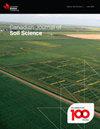Do cover crops on the Canadian prairies affect soil nitrogen cycling?
IF 1.5
4区 农林科学
Q4 SOIL SCIENCE
引用次数: 1
Abstract
Abstract For one of Canada’s most important regions of crop production—the prairies—it’s uncertain if cover crops can be successfully integrated into rotations; if so, will soil nitrogen (N) cycling be influenced to benefit main crops? To address these gaps, we compared a crop rotation with cover crops (CC) vs. without cover crops (LR) from 2018 to 2021 in Saskatoon, SK. The main crops were grown in sequence of wheat–canola–potato–pea; the cover crops included red clover, berseem clover/oat mix, fall rye, and a brassica cover. Yield and aboveground biomass were collected each year and analyzed to determine crop yield and N use efficiency (NUE). Soil N availability was monitored in various ways, that is, by assessing pre-plant soil nitrate, soil inorganic N (SIN) supply rate, and potentially mineralizable N (PMN). We found that the influence on soil N dynamics was restricted to the non-growing season where cover crops reduced SIN supply rate and nitrate content compared to the conventional practice without cover crops. Yet, rotations with vs. without cover crop did not differ in crop NUEs, yields, or in-season N dynamics. We found some evidence that diversifying rotations with cover crops may help the system to function more like perennial systems in terms of regulating N in the long run; but had limited impact during the three years studied. To ensure that cover crops are effective and functional on the prairies, innovative design approaches are needed to adapt cover crops to reach soil health goals under prairie conditions.加拿大大草原上的覆盖作物会影响土壤氮循环吗?
摘要对于加拿大最重要的作物生产地区之一——大草原来说,覆盖作物能否成功融入轮作还不确定;如果是这样,土壤氮循环是否会受到影响,使主要作物受益?为了解决这些差距,我们比较了2018年至2021年SK萨斯卡通有覆盖作物(CC)和无覆盖作物(LR)的轮作情况。主要作物按小麦-油菜-土豆-豌豆的顺序种植;覆盖作物包括红三叶草、三叶草/燕麦混合物、秋黑麦和芸苔。每年收集产量和地上生物量并进行分析,以确定作物产量和氮利用效率(NUE)。通过评估植物前期土壤硝酸盐、土壤无机氮(SIN)供应速率和潜在矿化氮(PMN),以多种方式监测土壤氮的有效性。我们发现,与没有覆盖作物的传统做法相比,覆盖作物降低了SIN供应率和硝酸盐含量,对土壤氮动态的影响仅限于非生长季节。然而,有覆盖作物与无覆盖作物的轮作在作物NUE、产量或季节氮动态方面没有差异。我们发现一些证据表明,从长远来看,覆盖作物的多样化轮作可能有助于该系统在调节氮方面更像多年生系统;但在研究的三年中影响有限。为了确保覆盖作物在草原上的有效性和功能性,需要创新的设计方法来调整覆盖作物,以实现草原条件下的土壤健康目标。
本文章由计算机程序翻译,如有差异,请以英文原文为准。
求助全文
约1分钟内获得全文
求助全文
来源期刊

Canadian Journal of Soil Science
农林科学-土壤科学
CiteScore
2.90
自引率
11.80%
发文量
73
审稿时长
6.0 months
期刊介绍:
The Canadian Journal of Soil Science is an international peer-reviewed journal published in cooperation with the Canadian Society of Soil Science. The journal publishes original research on the use, management, structure and development of soils and draws from the disciplines of soil science, agrometeorology, ecology, agricultural engineering, environmental science, hydrology, forestry, geology, geography and climatology. Research is published in a number of topic sections including: agrometeorology; ecology, biological processes and plant interactions; composition and chemical processes; physical processes and interfaces; genesis, landscape processes and relationships; contamination and environmental stewardship; and management for agricultural, forestry and urban uses.
 求助内容:
求助内容: 应助结果提醒方式:
应助结果提醒方式:


